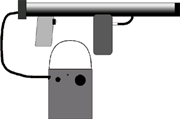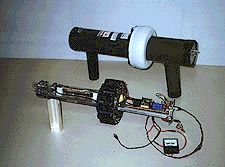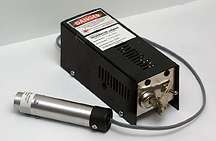 C02 Laser
C02 Laser 
| Length Overall | Power | Weight | Beam type | Action Type | Capacity | Power source |
| 30 inches | 6000 watt pulse (500us)
3 joules |
32 Pounds | I.R collimated
(1.06 micron beam) |
CO2 Gas Laser | 150 shots |
|
This particular model, is a modified version of an industrial cutting laser. The cost to build is just over $1500, and the cost was only kept this low by some shopping around, and scrounging. One very serious warning should be kept in mind: you can blind, or even kill yourself, building, and testing these devices. The military has been working on energy weapons for years, and has yet to be able to make a user safe, practical, soldier proof version. Laser devices of this power are no joke. As a class IV laser, this model can blast holes in metal, melt plastic, cause wood to burst into flames, and char flesh. Though the color of a laser beam varies, with the type being used, this particular model, being a CO2 laser, has a beam which is invisible (infra red). This makes the beam VERY dangerous to the user, since it can not be seen, and is perfectly capable of blinding, burning, and cutting.
Lasers operate at extremely high voltages, though they can be pulsed to use power sources of reasonable size. This
 particular
model uses a pair of AA batteries to provide power. The power source multiplies
the voltage thousands of times to get the tube to laze. This is similar
to the method used by photographic flash units. The capacitors store up
a high voltage charge, from the batteries, until sufficient voltage has
built up to fire the tube. Cycle time between shots can be 30 seconds to
a minute, depending upon the state of the batteries. The beam pulses for
only a tiny fraction of a second, but puts out enough power, in this short
time, to blast a hole in a piece of steel.
particular
model uses a pair of AA batteries to provide power. The power source multiplies
the voltage thousands of times to get the tube to laze. This is similar
to the method used by photographic flash units. The capacitors store up
a high voltage charge, from the batteries, until sufficient voltage has
built up to fire the tube. Cycle time between shots can be 30 seconds to
a minute, depending upon the state of the batteries. The beam pulses for
only a tiny fraction of a second, but puts out enough power, in this short
time, to blast a hole in a piece of steel.
A laser tube is used, in this model, rather than the far more common laser diode. This is because of the high efficiency (up to 10%), and very high power possible with the CO2 type laser. Though there are some reasonably high power laser diodes around, it is rare to find one that puts out more than 500mw, and almost impossible to find any that put out more than a few watts. This should not be taken to mean that laser diodes can not be dangerous. A whole new perspective must be used when discussing laser power levels. The ubiquitous laser pointer, pen, cat toy, or key fob, generally has between 1 and five milliwatts of power. These are amazingly dangerous, because they are so cheap, and common, that they are seldom taken seriously. A laser of a few milliwatts can cause permanent blindness. Most CD writers use a 35mw laser to burn pits into the substrate of a blank CD. A five watt laser can burn a hole in you. Lasers of ten watts are used to weld metals. Most cutting lasers are designed using laser tubes, but not all. Shown in the photo to the right, is a laser hand engraver, and it's power supply. This is a laser diode, of a few watts power, but is able to mark and burn wood, and plastic, and can etch metal.
My laser gun, actually has two lasers. There is a 5mw laser diode aiming beam, and then the high power laser tube, which is the main beam. The laser tube, is a CO2 unit, of the type used in industrial cutting, and engraving operations. Generally, a tube like this will need a massive power supply, and a heavy duty cooling system. These are required for the continuos duty cycle required by the production environment in which these devices operate. A laser designed as a weapon has a different set of requirements. A continuos beam, though a convenience, is not really needed in a laser weapon. This is fortunate, since it spares the need for a large and delicate power supply, and cooling system, allowing a system which is, marginally, portable.
So, is this the ultimate personal weapon? My own experiences tell me that it is not, though it may become the ultimate weapon at some future date. The advantages and disadvantages are listed below. Even discounting the weight, expense, delicacy, and other physical limitations of the mechanism itself, there is the matter of the beam generated. The beam, though dangerous, does not compare to the lethality of most firearms.
Characteristics of the laser as a weapon
- Silent
- Invisible beam (depending on frequency).
- Perfectly straight beam (no windage or elevation to worry about).
- Somewhat limited range (depending upon power)
- Delay between shots (depending upon power source)
- Beam is attenuated by snow, rain, smog, smoke, etc.
- Delicate, fragile mechanism.
- Heavy.
- Can be attenuated, or reflected by color of target.
- Expensive (relative term)
Many of the complaints directed against laser weaponry would be startlingly familiar to the musketeers of four and five hundred years ago. You can not drop a laser weapon, not can you immerse it in water. You can not fire one very often, and it is important to carry a large supply of powder (batteries), and be able to effect one's own repairs. Laser weapons are not very effective (or not effective at all) in certain types of weather. Laser weapons are slow, expensive, and difficult to make, and can not be used by soldiers who are not specially trained to them. They have limited tactical advantages in the field. Without exception, these are all of the complaints leveled at the old muskets, for the first hundred years or so of their existence. Even so, as with the case of the firearms hundreds of years ago, no one today doubts that laser weapons are the trend of the future. The chart below shows only a rough correspondence between firearms development, and laser weaponry development. This is a result of many peaceful uses being found for lasers, while there are few peaceful uses for explosive/projectile technology. Thus, the two lines of development do not correspond exactly. Still, there are some parallels to be drawn.
For the most part, millitary use of the laser has been confined to deployment as secondary weapons, or to increase the efficiency of the more traditional weapons. This includes their use as target illuminators for guided weapons, and rangfinders for tanks, and cannons. Secondary laser weapons are blinding weapons called dazzlers. A dazzler is turned upon enemy troops or pilots to destroy their vision. Permanantly blinded troops are not only neutralized as combatants, but also require the expendature of further resources. The traditional rule of thumb, is that one wounded soldier requires the services of three healthy soldiers. These types of logistical needs mean that, though banned by numerous treaties and conventions, laser blinders hold a particular attraction for some millitary planners.
What the military laser needs to make it truly practical as a small arm, is a new development in portable power. This could be a battery, or an expendable power charge like the powder charge used in a conventional firearm. There are considerable efforts being directed towards the refinenment of chemical laser. These may hold more promise for the development a small practicle personal weapon, then the use of the more traditional batteries or power packs. Presently, all of the world's most powerfull laser weapons are based upon chemical lazers.
There are presenlty three models of lazer weapons, of which I am aware, in deployment by the United States. None of these are what you could really call small arms. The first is deployed aboard the Boing 747, and is designed to detect, and destroy incomming ICBM's. The second is integrated into the venerable Spectre gunship, and is designed to shoot down tactical missiles. The third is a ground based system designed to shoot down ICBM's or blind/destroy orbiting sattelites. While there are certainly other systems under development, including one designed for mounting on the Army's hummer, the millitary is not exactly publicizing this work.
| Progress | Firearms | Date | Lasers | Date |
| Invention | Experiments with rockets and gun powder begin. Gunpowder is brought from China, where it is considered to be a scientific curiosity, and a part of religious ritual. Europeans soon see potential military applications. | 1250 (approx.) | Laboratory experiments with diamonds, rubies, high voltage power supplies, and flash tubes. | 1950's |
| large expensive laboratory units constructed for holography, and experimental uses. | 1960's | |||
| Limited practical models | Introduction of the canon. These guns are expensive, and difficult to produce, and have only limited practicality. Most are only capable of being fired several times a day, and have very poor accuracy, and quite limited range. Most canon are made by bell makers, the only craftsmen capable of producing castings of such a large size. Mini canons, mounted on pikes served as the first shoulder fired firearms. | Canon lock -to 1430
Matchlock 1410-1570 |
High power industrial units developed, along with lower powered units, at reasonable costs. Small scale industrial use is beginning. Military use is limited to laser rangfinders, or target illuminators. | late 1960's, to mid 1970's |
| Cheap low powered units available for standardized applications in home products (CD/DVD players). Large scale industrial use. Military use of energy weapons, is limited to development of large, powerfull, ground based, anti missile lasers. | early 1990's | |||
| Carryable models | Introduction of various shoulder fired models. This is the cutting edge of military tech, and musketeers are an elite, and highly trained force of technical experts. The normal soldier still uses the sword, the bow, or the lance. Some experiments with repeating arms, but the technology of the time is just not up to them. Some experimentation with rifled barrels. |
wheellock 1517-1590 snaphaunce 1525-1630 |
Medium power units capable of cutting, etching , available for small business, or home use. Low power units widely available at low cost. Blinding weapons (laser "dazzlers") are developed. | Late 1990's |
| Airborne, offensive laser developed as crew served weapon, for shooting down missiles, or high speed aircraft. Weapon uses lens ground from salt crystal to overcome problems encountered working with optical glass. | 2000 | |||
| Standardization | Standard calibers, and action types, make guns more dependable, and easier logistically, but still require experts to use. Bows, sabers, and swords are still the preferred weapons. There is some experimentation with breach loaders, and further attempts at producing repeating arms. Rifling is made a standard feature of most arms. | flintlock 1620-1840
percussion 1800-1870 |
High tech integrated weapons system built around laser weapon, with conventional cartridge weapon. Heavy, expensive, and limited in endurance. There are also logistical problems to work out. | In development only. Will probably happen in the next 10-15 years. |
| Mass production, and refinement. | Flintlocks, and latter percussion guns, along with large scale production, make the gun a tool of the masses. The typical soldier now carries a gun, as does the civilian hunter, and householder. | 1650-present | Lasers become practical, serviceable weapons of light weight, capable of being operated and maintained under combat conditions by average troops. | Yet to occur |
| Repeating arms developed (non cartridge) | First practical repeating arms developed (black powder revolvers). | 1820-1880 | Yet to occur | |
| Metallic cartridge developed | Rimfire, and then centerfire metallic cartridges developed. | 1850-present | Yet to occur | |
| Rapid fire, automatic arms developed. | Mechanical gattling type guns developed. Mechanical systems later designed to use the energy of recoil to cycle actions. | 1880-present | Yet to occur |